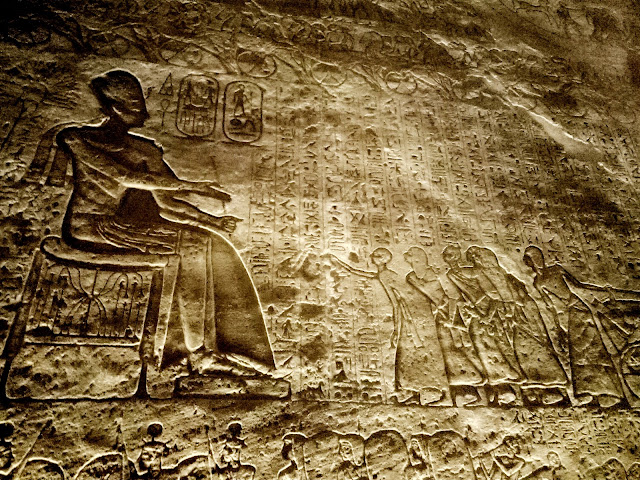The Great Temple at Abu Simbel
The Great Temple at Abu Simbel is one of the two massive rock-cut temples in the village of Abu Simbel in Upper Egypt. It was constructed during the reign of the 19th dynasty Pharaoh, Ramesses II (also known as Ramesses the Great) who ruled Egypt for approximately 66 years from 1279 BCE to 1213 BCE. It is estimated that the construction of the great temple took approximately 20 years. The temple is dedicated to the Egyptian gods Amun, Ra-Horakhty, Ptah and as well the pharaoh Ramesses II himself.
 |
| The Great Temple at Abu Simbel |
The complex which consists of the great temple and the smaller temple (dedicated to goddess Hathor and Queen Nefertari, the chief wife of Ramesses II) was relocated in its entirety in 1968 to higher ground to avoid it being submerged by Lake Nasser, the Aswan Dam reservoir. Between 1964 and 1968, the entire site was carefully cut into large blocks, dismantled, lifted, and reassembled in a new location 65 meters higher and 200 meters back from the river.
The entrance to the temple is flanked by four colossal statues, each representing Ramesses II seated on a throne and wearing the double crown of Upper and Lower Egypt. The statue to the immediate left of the entrance was damaged in an earthquake, causing the head and torso to fall away. Next to Ramesses's legs are a number of other, smaller statues. These statues depict his chief wife, Queen Nefertari; his queen mother Mut-Tuy; his first two sons, Amun-her-khepeshef and Ramesses B; and his first six daughters: Bintanath, Baketmut, Nefertari, Meritamen, Nebettawy and Isetnofret.
 |
| The entrance to the temple is flanked by four colossal statues of Ramesses II |
The hypostyle hall in the inner part of the is supported by eight Osirid pillars depicting the deified Ramesses linked to the god Osiris (the god of fertility, agriculture, the afterlife, the dead, resurrection, life, and vegetation), to indicate the everlasting nature of the pharaoh. The colossal statues along the left-hand wall bear the white crown of Upper Egypt, while those on the opposite side are wearing the double crown of Upper and Lower Egypt.
 |
| Examples of the colossal statues in the hypostyle hall |
The bas-reliefs on the temple walls depict
battle scenes related to the military campaigns of Ramesses II (including the
“Battle of Kadesh”, on the Orontes River in present-day Syria, in which the
king fought against the Hittites) and images of the king worshipping ancient Egyptian deities.
 |
| Examples of the bas-reliefs depicted on the temple walls |
The second pillared hall has four pillars decorated with scenes of offerings to the gods. This hall gives access to a diagonal hall, in the middle of which is the entrance to the sanctuary. Within the sanctuary, there are rock cut sculptures of four seated figures depicting the god Ra-Horakhty, pharaoh Ramesses II, the god Amun-Ra and the god Ptah.
 |
| The sanctuary with the rock cut sculptures of four seated figures depicting the god Ra-Horakhty, pharaoh Ramesses II, the god Amun-Ra and the god Ptah |
It is believed that the axis of the temple was positioned by the ancient Egyptian architects in such a way that on October 22 and February 22, the rays of the sun would penetrate the sanctuary and illuminate the sculptures on the back wall, except for the statue of Ptah, a god connected with the realm of the dead, who always remained in the dark.







Comments
Post a Comment